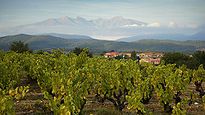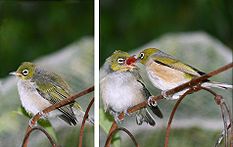User:MIckStephenson/sandbox
- Cropping, rotating and perspective correction are generally acceptable. A subject may be illustrated more prominently, faithfully or accurately by using one or more of these techniques.
- Sharpening/blurring, tonal corrections and colour correction are generally acceptable. A subject may be illustrated more prominently, faithfully or accurately by using one or more of these techniques.
Cropping, rotating and perspective correction are generally acceptable. A subject may be illustrated more prominently, faithfully or accurately by using one or more of these techniques.
In support of <1000px submissions
[edit]




I would like to propose that the resolution size in criterion 2 be upheld more regularly than it is ignored.
This comment was originally posted by me on the WP:FPC page in defence of this image (opposite)
I'm honestly not just being obtuse when I say I really like this image and think a lot of the oppose comments above are a bit harsh and even off the mark. I'm thinking more of future submissions when I say we shouldn't, and frequently don't, condemn an image because of the manner in which it was nominated (quite often a successful FP will have been edited by contributors here before it made the grade) and yet this one above made the mistake of being submitted too big, nothing else.
Encouraging - even insisting on - 3MP+ submissions is unfair on images which look perfectly good at 1000x750, as this one does. It looks awful at twice the size but I could care less what it looks like twice the size, it's a really nice image at full-screen resolution. I've been looking in here for about six months and seen some travesties of non-promotions based solely on dimensional image size and pixel-level clarity. 1000px is all that is necessary (a) for appreciation purposes and (b) to allow for reasonably sized print repro. 1000 pixels makes for a good 4-6 inch print in repro and looks great on my monitor.
This is why the minimum size guideline is.. 1000pixels.
At this size I can tell the image above is a fine capture made with equipment better-suited to small repro and screen resolution viewing: why insist on pixel-picking at unreasonable magnification, as if 30x40 is the smallest size human beings can perceive for pictoral evaluation purposes? I can think of some very fine images of which that most certainly isn't true.
This rant isn't over, but really do have to go out now.. I'd welcome any comments in the mean time.
mikaultalk 20:14, 22 April 2007 (UTC)
- (I had an edit coflict with Mick and did not take has new text into account while writing this.) Here's my rant, then. I just want to remind you that pictures that barely meet the guideline are often shot down for just that, and not without good cause. Why should we fix the standard at a low level? Obviously, if a picture cannot be retaken and is low resolution or lower quality, it is an exception. Otherwise, however, why should we let a low quality 3 megapixel image pass when we can get a high quality 3 megapixel image? You seem suggest we keep an artificial minimum to image quality. If the image could be captured at 3 megapixels, somewhat out of focus, soft, and poorly composed, then it must be possible to take a picture at 3 megapixels, in foucus, sharp, and well composed. Why keep the minimum when more is possible? I believe that any image that meets the guidelines but that goes not further should not pass, and that seems to be the way featured picture candidates is currently. 1000 pixels is simply not going to meet the requirements for the next generation of high-definition standards. Furthermore, 1000 pixels will not provide much more detail zoomed in, even at current standards, than is provided in the preview. Just as an example, look at this picture. Sure, it could have been uploaded 1132 by 855 pixel image, and I invite you to downsaple it yourself. Can you see the intricacy of the cloak of the Statue of Freedom? Can you see the lettering on the signs on the first storie doors? Featured demands something extra, not just the minimum. I cannot clearly see your POV, but I would be happy to change my mind if you address the issues that I have just stated. J Are you green? 01:00, 23 April 2007 (UTC)
- If you don't mind, I'll answer your points after my last comment below, for continuity purposes - mikaultalk 10:10, 23 April 2007 (UTC)
Re. the Orkney chapel shot, I didn't notice the original and what I'd taken for USM-exaggerated edges actually appears to be the result of clumsy masking, on second viewing, although the crop and tonal tweak is the making of it. There's some chromatic aberration, of course, as you'd expect from a compact. Maybe I like it a tiny bit less than I did (the fact is I have a soft spot for Scottish churches :)) but my point doesn't concern the absolute merits of this particular image, it's the relative demerits of assessing all images against those taken with two thousand dollar optics.
As someone pointed out in another comment on this nom page, there are some good FPs taken on point-and-shoot cameras. There are also many older FPs which are well under the 1000px guideline and which I would strongly oppose any delisting of, for reasons I gave earlier - they do it for me at 6x4, more than they would at 20x16. The church one -tonal correction, mask outline and all- works well enough at 1200pixels to be considered primarily, not incidentally, on its merits as a picture.
FP images like this or this or this (all thumbnailed opposite) just don't cut it at mega-size and are (quite rightly) FP images because they're fine, descriptive photographs, as the one of the church is, at this smaller size.
The problem is that the resolutionaries (hehe) are having it their own their way, effectively enforcing a 3MP image size "rule" which subjects less detailed shots to the same misplaced criticism as this one. 3MP+ compact shots look much, much better downsampled to 1200 pixels; it's what they were designed for. You click on the FS file here and instead of a full-screen picture you get a less-than-attractive display of jpeg artifacts, fringing, noise reduction and other in-camera efforts at correcting these issues - correcting them for 1200 pixel display.
- All I'm suggesting is that, with certain exceptions (macro shots, most landscapes and things like maps) 2500 pixels of horizontal resolution should be a nice bonus, not a FP prerequisite, and compact camera submissions should not have to conform to such resolution stipulations. I'm convinced submission quality would be raised, not lowered, if this were more regularly observed and positively encouraged. mikaultalk 00:38, 23 April 2007 (UTC)
- [Re. thegreenj above:] I probably need to restate my case more clearly and I'm grateful for your comprehensive reply, which will help me do so. Your main points:
- 1 I'm not arguing to fix the standard at a lower level. I would like to see the current 1000px longest-edge minimum recommendation respected for images which are not suited to higher magnification.
- 2 A high quality 1MP image is way preferable to a low quality image at 3MP, even if they come from the same source file, which might often be the case. Some images need to be viewed at 3MP resolution, some don't and look awful if they are. If you insist on 3MP uploads, there's no easy way of viewing it at its best, ie. at full-screen size. The most important point I'm trying to make is that Quality is not an exclusive property of resolution. If we wanted to exclude images based on their suitability for A3 enlargement, it would say so in the crtieria. We don't; hence the minimum is set, sensibly, at 1MP. High qualtiy is perfectly feasible at this resolution; see the examples above.
- 3 I'm not sugesting a minimum quality, I'm arguing in support of the roundly ignored minimum resolution which only has some bearing on quality. High pixel resolution simply isn't the most important factor, IMO, whether we're talking FP or not. Does a Featured Article have to weigh in at 70Kb? Must the greatest paintings always be made on huge canvasses? Can't small be beautiful too?
- 4 Zooming-in is for nerds ;)) ..seriously, I like to look closely at (some) images as much as the next person, but there are many which are better appreciated sitting back. Viewing distance is a crucial factor in image appreciation. The last competition I entered stipulated 10x8 prints, smaller than the size of my 1024x768 monitor.
- 5 The image (bottom thumb opposite) you linked to might show the nostril hairs on the guard on the balcony and be beautifully exposed, but it's skewed and it's cropped-off at the bottom, half the lights are off and the image generally is boring and unopportune. It could clearly be reshot a little earlier (for the sky) or made more compelling with some cloud cover or - anything to lift it out of the "ho-hum, another 10MP stich-up" run-of-the-mill. Forgive me, but (like you?) I wouldn't have supported this at 1MP and zooming in to it's awesome mega-detail simply isn't enough to stop me reaching for the "oppose" button. As you say, it's nothing special at 1132 by 855. As I said before, quality is not an exclusive property of resolution and IMO high resolution (or rather, techincal competence) is far from enough for FP.
- 6 "Featured picture" doesn't and shouldn't mean featured cameras, nor featured optics. "Sharp", "well-exposed" and "high resolution" are things cameras do, often without a great deal of help from a competent operator. Pictures are what photographers make, whether on a Canon 5D with a 2.8 prime or a 100-dollar compact.
- mikaultalk 10:10, 23 April 2007 (UTC)
Circles of confusion?
[edit]One of the more techincally challenging concepts to grasp in photography is one related to depth of field, the aptly-named circle of confusion. Just as depth of field is not well-defined without asessing factors like lens, camera and viewing conditions (effectively, assumptions about what will appear to be in focus at a certain printsize) so we should avoid judging the suitable "sharpness" of an image at 100% pixel-for-pixel enlargement on our monitors, when the real issue is how it will look at the much smaller magnification (typically around one fifth of 100% screen resolution size) it will be once printed. Except for the exact point at which the camera is focused, everything in the image plane is to some degree some out-of-focus (abbreviated to "OOF" here) on a smoothly varying range between perfect focus and total blur. The amount of tolerable OOF detail in the final image is determined by what we assume to be its final viewing size, as well as the relationship between OOF areas and sharpness in the image plane. Critically, everything, apart from the absolute point of sharp focus is out of focus if we look carefully enough.[1] Ignoring print size considerations for the moment, the majority of us these days view our featured pictures at around 1024x768 pixel resolution (the SVGA standard), which is to say, if the picture was your wallpaper/screensaver it would be set to this size. Assuming the FP is nicely cropped to the the relevant subject area, there's often no reason for the casual Wikipedia user to view it any bigger.
- Please have a look at this http://www.kenrockwell.com/tech/mpmyth.htm. Ericd 19:55, 30 April 2007 (UTC)
- Good old Ken :o) he does love to go off on one.. he makes some good points about digital capture, one I was only half-aware of (horizontal pixel res was an eye-opener) although typically free with the hyperbole for the most part. Interesting and pertinent argument though, thanks! mikaultalk 11:29, 1 May 2007 (UTC)
- The statement about horizontal pixel res is a bit misleading though. If a 3mp camera has 2000px and 14mp has 4500, thats more than two times the viewable width at the same DPI and of course it is also more than two times larger in height too. In reality, it is 2.25 * 2.25 larger in total area, or almost five times more actual detail, which is what the MP really is. Of course having more MP isn't necessary if you aren't interested in the extra detail available and I will happily concede that most digital camera buyers won't appreciate a higher resolution camera because they'll only ever print 4x6 or display on a low resolution monitor, but that doesn't mean there are real tangible benefits that some people will pay good money for. His points are aimed more at the brainless consumer than the enthusiasts and photographers. Diliff | (Talk) (Contribs) 12:07, 2 May 2007 (UTC)
- Good old Ken :o) he does love to go off on one.. he makes some good points about digital capture, one I was only half-aware of (horizontal pixel res was an eye-opener) although typically free with the hyperbole for the most part. Interesting and pertinent argument though, thanks! mikaultalk 11:29, 1 May 2007 (UTC)
- Please have a look at this http://www.kenrockwell.com/tech/mpmyth.htm. Ericd 19:55, 30 April 2007 (UTC)











